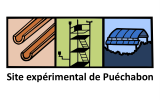Holm oak (Quercus ilex L.) forests cover about 350 000 ha in southern France where they were traditionally coppiced on short rotations (from 7 to 30 years) for charcoal or tannins production. These coppices have been generally abandoned and under-logged since the second half of the 20th century which resulted in alterations of the forests structure mainly due to ageing and increased the forests sensitivity to perturbations such as pests, fires and drought.
Thinning has been regarded as a means-considered as a way to address the structural ageing (Ducrey, 1988) and, more recently, to mitigate the impact of climate change on Holm oak forests (Rodríguez-Calcerrada et al., 2011). Thinning has a positive effect on growth and vigour of seasonally dry forests by decreasing the stand density and leaf area, and therefore releasing the water competition amongst the trees.
The main objective of the study is to assess experimentally the long-term effect of thinning on tree growth and wood production in a Mediterranean Q. ilex coppice.
The thinning experiment started in 1986 and is composed of 15 plots of 1000 m2 each, divided into 3 blocks. The last clear-cut occurred in 1942 for the blocks 1 and 2, and in 1928 for the block 3. Selective thinning from below (sensu Assman, 1970), which consists in removing the smallest stems to the benefit of the biggest ones, was applied in March 1986 when stems were 44 years old in the blocks 1 and 2 and 59 years old in the block 3. Five thinning intensities were applied corresponding to approximately 0%, 25%, 45%, 60% and 80% of the basal area removed. Each treatment level was applied to a 1000 m² plot and replicated in each of the three blocks. The number of stems that were removed varies between 55%, for T25% and 90% for T80%.





